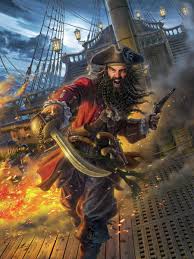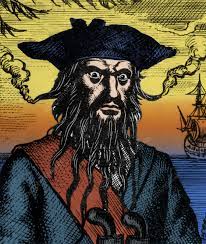Blackbeard: Dreaded Pirate of the High Seas and Enduring Legend
Blackbeard: The Terrifying Legend of Edward Teach
Blackbeard, the notorious pirate whose real name was Edward Teach, continues to be one of the most infamous and feared figures in maritime history. His ruthless exploits and distinctive appearance, characterized by a long black beard and slow-burning fuses woven into it, have left an indelible mark on the legacy of piracy. Born around 1680 in Bristol, England, Blackbeard’s life and career were shrouded in mystery and brutality, making him a legendary figure in the Golden Age of Piracy.
Early Life:
Little is known about Blackbeard’s early life, contributing to the enigma surrounding this pirate. Historians believe he was born in the late 17th century in Bristol, a city with a maritime tradition. Some accounts suggest that he served as a privateer during Queen Anne’s War (1702–1713), a conflict between European powers and their colonies in North America. Privateers were essentially legalized pirates, authorized by governments to attack and plunder enemy vessels during wartime.

Edward Teach, AKA Blackbeard
The Transformation into Blackbeard:
Following the end of Queen Anne’s War, many privateers found themselves without legitimate employment, leading some to turn to piracy. Edward Teach was no exception. By the early 18th century, he had transitioned from a privateer to a full-fledged pirate, adopting the alias “Blackbeard” to strike fear into the hearts of his enemies.
Blackbeard’s physical appearance played a crucial role in creating his fearsome persona. His long, jet-black beard, which he braided and adorned with slow-burning fuses, emitted smoke during battles. This gruesome spectacle not only terrified his adversaries but also served a strategic purpose by obscuring his face and adding an element of psychological warfare.
The Queen Anne’s Revenge:
One of Blackbeard’s most famous exploits was the capture and conversion of a French slave ship, La Concorde. Renaming it the Queen Anne’s Revenge, Blackbeard outfitted the vessel with 40 guns, making it a formidable force on the seas. The Queen Anne’s Revenge became the flagship of Blackbeard’s fleet, and with its firepower and menacing appearance, it symbolized the terror that Blackbeard intended to spread.
Piratical Reign:
Blackbeard’s reign of terror extended from the West Indies to the eastern coast of the American colonies. His notoriety grew as he captured numerous vessels and amassed a considerable fortune. He was known for his cruelty, often marooning his victims on deserted islands or subjecting them to torture to extract information about valuable cargo.
In 1718, Blackbeard blockaded the port of Charleston, South Carolina, creating panic and demanding a ransom for the release of hostages. This audacious move further solidified his reputation as a ruthless and cunning pirate. The authorities, realizing the threat Blackbeard posed, launched a concerted effort to capture or kill him.
The Battle of Ocracoke Inlet:
The end of Blackbeard’s pirate career came in a dramatic and violent fashion in the waters off Ocracoke Island, North Carolina, on November 22, 1718. A naval force led by Lieutenant Robert Maynard engaged Blackbeard and his crew in a fierce battle. Despite being outnumbered, Blackbeard’s reputation for invincibility seemed to hold until a decisive moment when Maynard’s forces overwhelmed the pirates.
In a brutal hand-to-hand combat on the deck of the ship, Blackbeard sustained multiple gunshot wounds and numerous sword cuts. Ultimately, it took several men to bring him down, as he fought fiercely until the very end. Blackbeard’s lifeless body, with multiple wounds and his head nearly severed, was thrown into the sea. Legend has it that even in death, Blackbeard’s body swam around the ship before sinking, a macabre testament to his enduring mystique.
Legacy and Myth:
Blackbeard’s legacy extends beyond his death. The gruesome details of his demise only fueled the legend surrounding him. Tales of buried treasure on the Outer Banks of North Carolina, where he frequented, have persisted, although no substantial evidence of such treasure has ever been found. The image of Blackbeard, with his smoky beard and fearsome countenance, continues to captivate popular culture, appearing in books, movies, and other forms of entertainment.
The enduring fascination with Blackbeard is a testament to the enduring allure of piracy and the mystique surrounding those who dared to live outside the law. Whether viewed as a ruthless criminal or a symbol of rebellion against oppressive authorities, Blackbeard remains a complex and intriguing figure in the annals of maritime history.

The slow burning fuses woven into his beard
In conclusion, Blackbeard’s life was one of brutality, cunning, and audacity. From his early days as a privateer to his infamous reign as a pirate, Edward Teach, aka Blackbeard, carved a lasting legacy as one of the most feared and enigmatic figures of the Golden Age of Piracy. His notorious exploits, dramatic demise, and enduring mythos ensure that the legend of Blackbeard will continue to fascinate and terrify generations to come.
- Posted in:
- Legends and Myths
- Naval Warfare
- Pirate History
